


An Engineer in the Woods, Installment 18: Oak Trees, Part Two – Unit Conversions, Acorns, Leaves and Poo
Sunday, December 2, 2018Last month I shared why we love our trees. This month I am sharing some of the less positive aspects of living under a dense tree canopy. Here is my annual calendar of frustration with our trees:
Spring
All plants (except mosses and ferns) produce flowers, and that includes oak trees. Oak flowers are a MESS. Continually from mid spring thru early summer the oaks that cover our property drop piles of six-inch-long strings of yellowish-green, pollen-laden flowers that spot our cars, cover our roof, plug our gutters, stain our deck and track into the house. Sweeping them off the cars, the front walk and the deck is nearly a daily chore and after I’m certain that they are done for the year (usually close to July), I take the leaf blower up on the roof to blow it off and use a push-broom to clear the gutter screens. Kristen keeps 9-1 dialed on the phone and waits to hear the thud if I fall off before she dials the second 1.
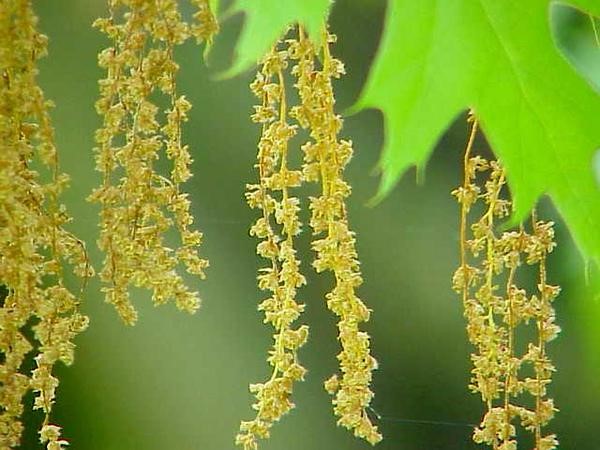
Summer
Small Acorns:
About 6-8 weeks after the last of the oak flowers have stained the deck, the first small burr oak acorns begin to fall. Because they are small they fall silently, and they arrive unexpectedly. Every morning around 5:00, when the light is dim, and my eyes are cloudy, I clean-out yesterday’s grounds from the coffee pot, and dump them into our ancient galvanized “Grounds Bucket” on the deck by the kitchen sliding glass patio door. Our use for old coffee grounds is important to our life in the woods and will be the subject of a future blog.
I seldom put on my house-slippers in the early morning and stepping barefoot onto the deck after the second or third week of August is HAZARDOUS. The small acorns, invisible to the aging, blood shot eyes dig into the bottom of your foot and stick there, sending shooting pain from your sole through your soul! The next step after crippling one foot usually results in the impaling of the other heel, the dropping of the grounds, and a torrent of colorful language that leads to the illumination of porch lights for miles. Neighbors ask if I torture our dog.
I don’t bother trying to keep up with the small acorns on the roof, but I do sweep the deck and front walk every other day during this initial acorn drop period of 2-3 weeks.
Large Acorns:
As the deluge of small acorns ceases, the pounding from thousands upon thousands of GIANT acorns begins and continues throughout September. The trunk of my otherwise immaculate car looks like the lunar surface thanks to the hundreds of pounds of squirrel and deer food that fall from the sky onto our property starting in late-August. The following picture is of our kitchen deck about 12 hours after my previous afternoon’s sweeping:
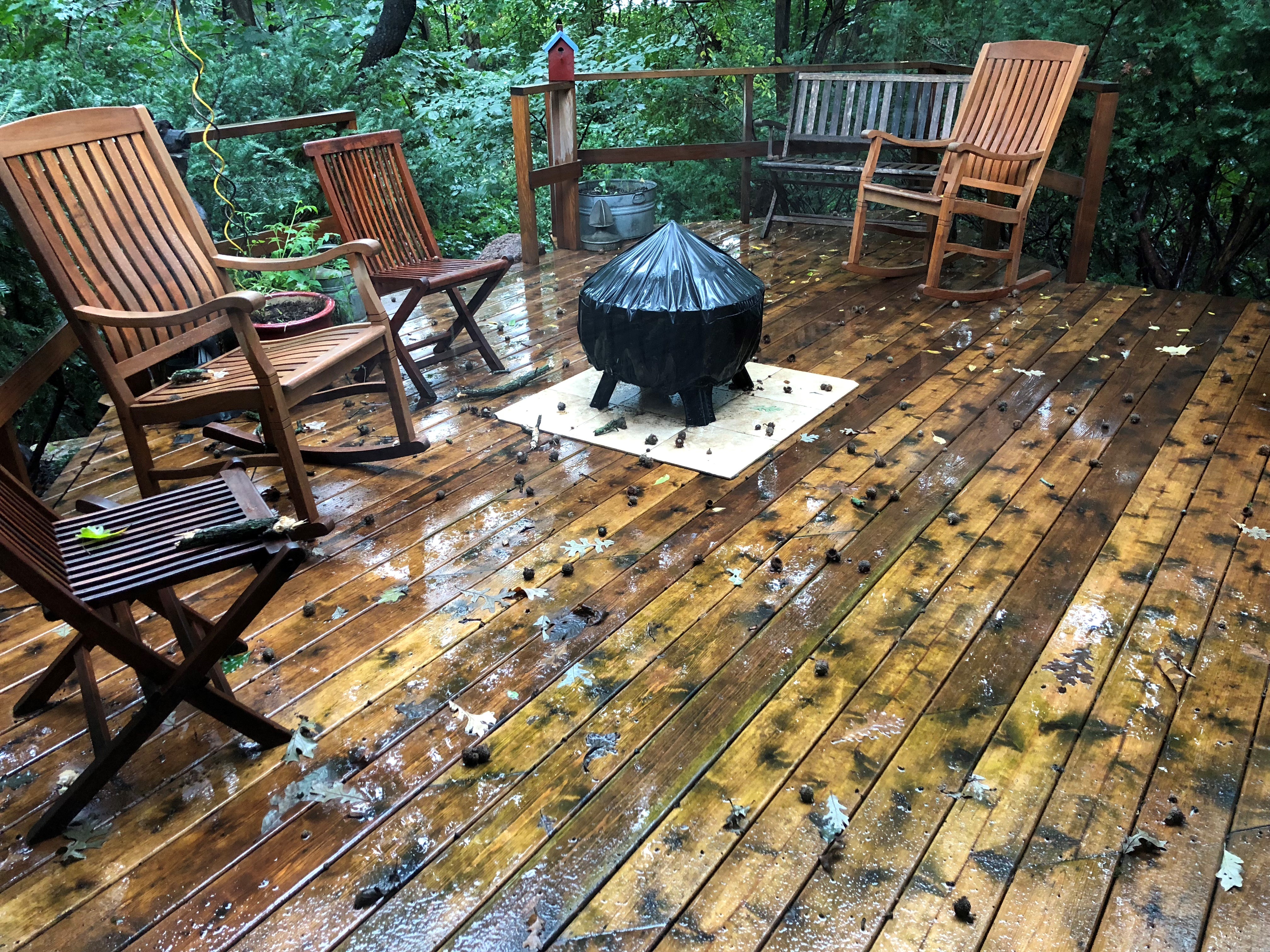
Each acorn that crashes onto my car, the deck, the fire pit, the grill, the small shed, the large shed or the roof produces a unique, and occasionally jolting sound. Although we are used to it, visiting friends and family are not and it’s a little funny to watch them startle. My Mother-In-Law’s responses are best. EVERY acorn gets a “Jeesh”, and an involuntary flinch. In a typical 2-hour visit that means that I have to suppress a giggle 30-40 times – startling your Mother-In-Law never gets old… Our favorite ones drop from about 75 feet onto the roof, bounce, hit again, bounce, hit again and scamper across the kitchen roof, off the edge and onto the deck for another hit-bounce-hit…good times. When there is a breeze, they fall in torrents sounding like a popcorn popper or a crackling fire.
During the large acorn pounding the squirrels and deer get fat and lazy. We’ve seen bloated deer lie in the yard and roll their heads sideways to the grass to lap-up succulent manna as it falls from heaven. This is the one time of year that the squirrels leave the birdfeeders alone, as it is less effort to dig thousands of holes in the lawn and push acorns into them, than it is to climb onto a birdfeeder and get yelled at by an angry old squirrel-hater (definitely a future critter blog!).
A young doe nibbles on acorns from the driveway next to my dented car.

The following picture shows our three different types of oak acorn.
From left to right: White (Swamp) Oak, Red Oak, Burr Oak
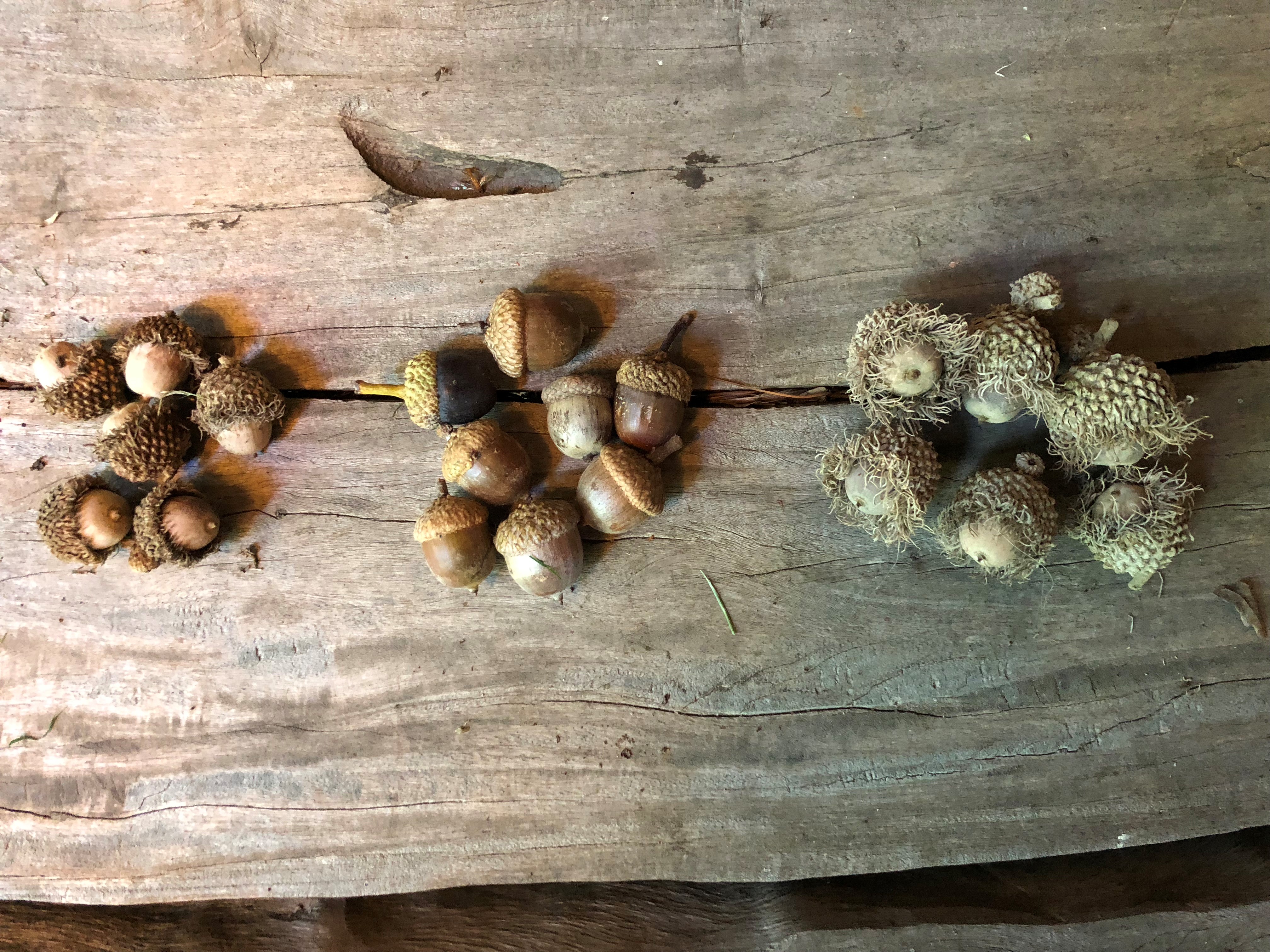
This picture shows what my acorn collection looked like about 36 hours
after I left it unattended outside our front door.
CRITTERS!!!
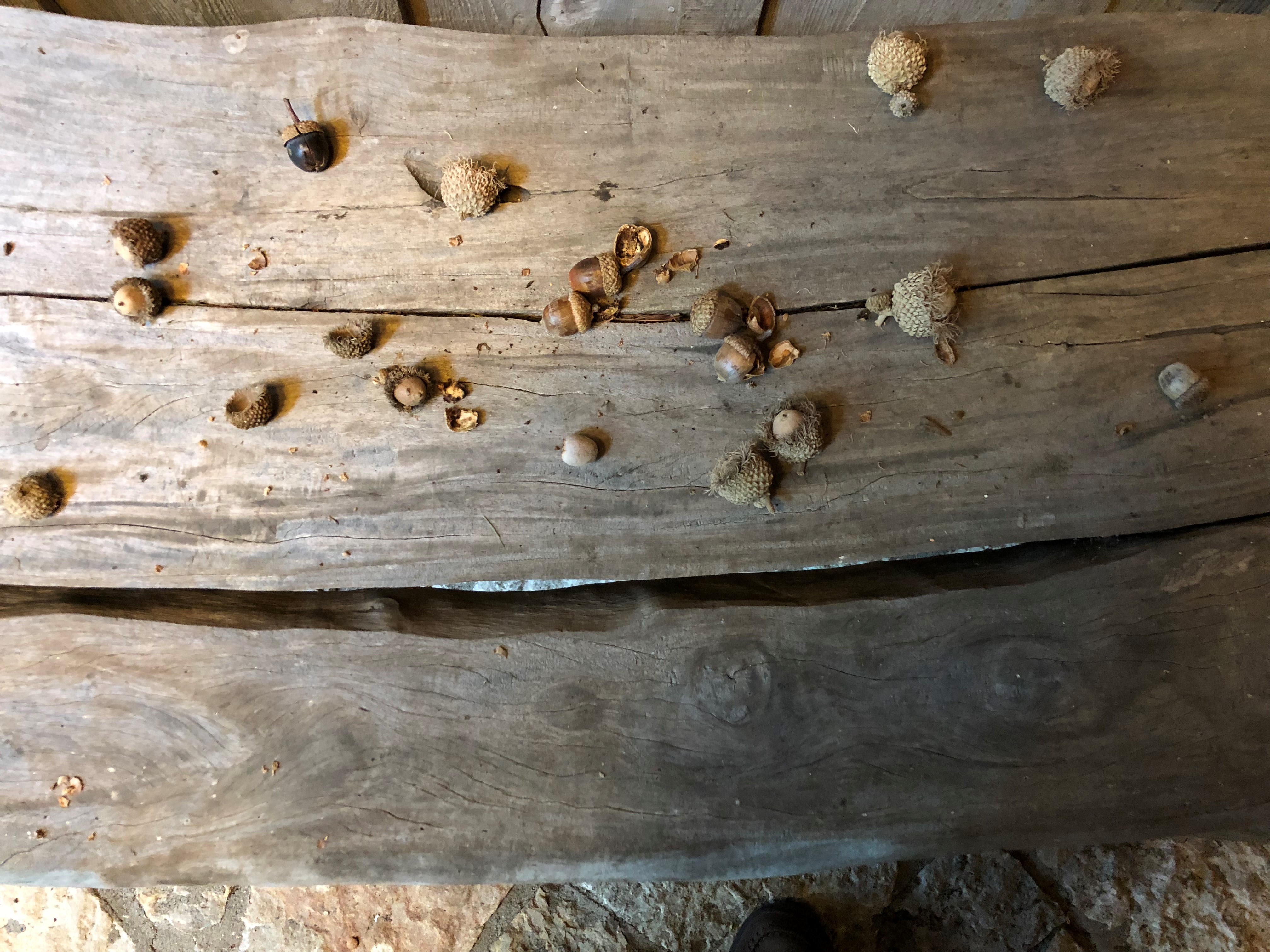
Fall
On my “someday” list is to identify each of the trees in our yard and mark them on a map. Sure there are some that I know very well – the giant Burr Oak that is next to the picture window in the Great Room, and it’s twin at the point of the lanai; the two Lindens (Basswoods) at the opposite back corners of the house; the Osage Orange (Hedge Apple) near the point of the deck; the Shag-Bark Hickory next to the pond; the Chokecherry that the birdfeeders hang on… but most of the oaks I generally just group as “oak.” As I was growing-up Mom and Dad would say “that’s a red oak,” or “a burr oak,” or “a white oak,” and I can identify them by leaf or acorn. However, with giant mature trees you can only see the leaves and acorns when they’re on the ground, and with so many trees intermingled it’s difficult to figure what fell from where…but it really doesn’t matter, except in the fall.
The plate-sized Cottonwood leaves usually have the street covered throughout September, but I really have to be in a “cleaning” mood to rake the street, so I really don’t care. But the real work begins when the oak leaves begin to drop during the third or fourth week of October. We measure the depth of the leaves on our yard in fathoms (a fathom is about 6 feet). When I was a kid we knew that someone was coming to the door when you heard shuffling in the leaves on the driveway and front walk. Every year I promise that I will keep-up with the leaves. Every year I fail miserably.
The white (swamp) oaks drop most of their leaves early but hold a few over the winter. They’re in the backyard and not near the house. Those leaves get mulched when I mow, but once they fall they stay on the ground because we’re the only people that can see them. Although some years, this year included, I blow some of them into the burn pit, so that the grass doesn’t get smothered and die.
The burr oaks (also a type of white oak) drop their leaves a little at a time through October and November. Some trees are completely bare by Election Day and some keep their covers on past Thanksgiving. Don’t ask me why, I’m not a tree.
The red oaks hold tight well into November and then drop their leaves in fits, not ending until the middle of December and always keeping a sparse covering until spring. These are the trees that threaten my life because they never fully cease with their blanketing of our roof and I’m never quite sure when they are mostly finished…
Our roof has a 3:12 pitch which is very flat for northeastern Illinois. Because it is so flat, most acorns that fall on it stay on it; most leaves stay there unless there is a late fall tornado; and any sticks, branches or critter poo pile up until I sweep, rake, blow, or fling them off. If I leave any of this detritus on the roof, multiple issues occur:
-
The roof valleys fill with dirt, allowing plants to grow and destroy the shingles.
-
The plugged valleys cause water to backup under the shingles thus destroying them and allowing water to drip into the house.
-
The wet leaves freeze to the roof in the winter and hold water under the shingles. Ice lenses form under the shingles causing them to pop and split.
-
The drain on the flat portion of our roof over the front entry plugs and gunk laden rainwater flows into the exterior ceiling light, onto the front walk and splashes anyone trying to use the front door during a rainstorm.
-
My wife Kristen and our fancy neighbors complain that we look like hillbillies. The complaint is valid for many reasons, why allow one more?
However, I like to limit my sweeping/raking/blowing efforts of the roof for the following reasons:
-
Shingles are not designed for regular foot traffic.
-
I’m not quite as skinny as the nine-year-old that you may have seen in the movie that was included in September’s blog (slight understatement). Since I have British ancestry I have started reporting my weight as “about 14 Stones” or, for the non-Anglophiles, “right around 100 kilograms” or, “about the same as the weight of 25½ British gallons of Guinness Stout” (my weekly consumption, and probably a reason for non-slimness). Any conversion of these values results in a fourth option, “more poundage than belongs on the roof.”
-
Leaves, moss, acorns, branches and critter poo (and if I wait too long, snow and ice) make the roof treacherous due to the potential for slipping and tripping.
-
I don’t like heights.
And those are the points that lead to the quandary. I don’t want to go on the roof to blow it off until the red oaks have finished dropping at least most of their leaves, but if I wait too long the frozen leaves will stay there until spring.
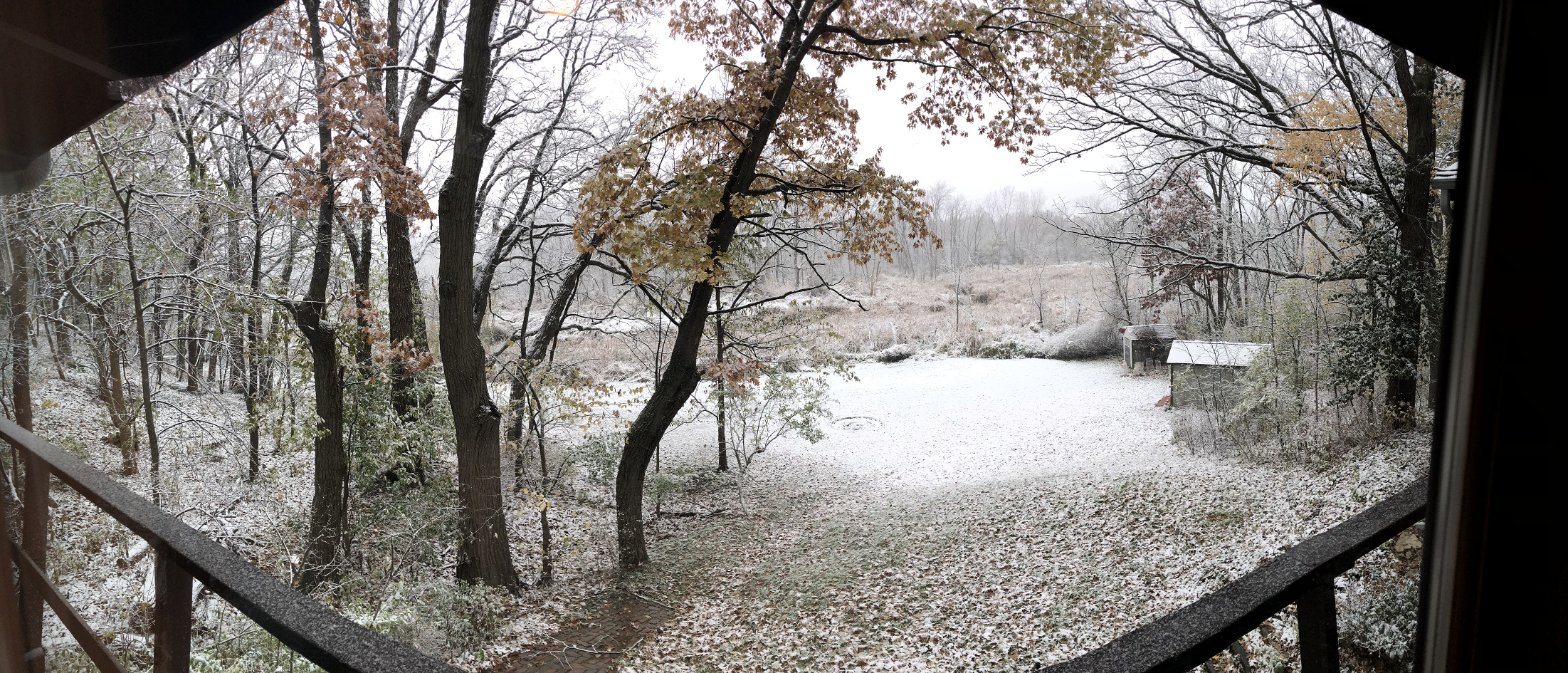
The first Snowfall of 2018
Looking Out of Our Bedroom Window
White Oaks to the left background, bare;
Red Oaks to the center foreground and right background, full of leaves;
Burr Oaks to the right foreground and right background, bare
(the ones in the front and side yards [not pictured] were still almost fully leaved)
Last year I found a partial solution, I asked my son Richard to go up on the roof instead of me. It led to some colorful discussions:
“Dad! How do coyotes get on the roof?” was my son’s bellow from over my head as he explored.
“They don’t,” I shouted back from the side deck below.
“Well they must be getting up here somehow.”
“Why do you say that?”
“Something big has been crapping all over the place.”
“That’s racoon poo.”
“It’s too big for racoons, and there’s A LOT OF IT!”
“We have a LOT of BIG racoons.”
“The blower won’t move some of the biggest piles of poo.”
“Here’s a shovel,” I said as I extended an old coal shovel over the eaves while standing on my tiptoes on the deck.
“Scrraaape... scrraaape... scrraaape...step...step...step...FLINGNGNG…THUDD!...splaaaattttt…”
“Please don’t fling the poop on the deck, or over my head.”
“sorry”
“Something died up here.”
“Fur, feathers or stink?”
“Just bones.”
“Big or little bones?”
“About six or seven piles of little bones.”
“Those are owl pellets.”
“???”
“Owl puke. Owls don’t digest fur, feathers, or bones, so they regurgitate them into little piles called castings or pellets.”
“The piles aren’t that little.”
“Big owls.”
“It’s kinda gross up here.”
“That’s why you’re up there and I’m not.”
This fall Rick stayed at law school for some reason…I miss the slave labor.
Don’t fling poo!*

Howard
*(a quote from my favorite non-existent grade school poem, “Brown Spots on the Walls,” by Hugh Flung Poo)